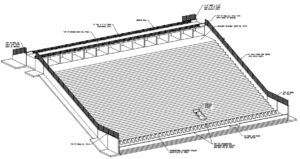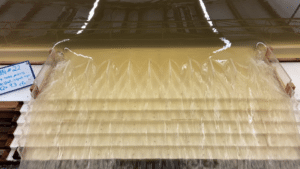Boiling Springs: New Ideas For Upgrading Old Dams
As rural areas across the United States increasingly get developed with new homes, roads and businesses, aging dams that posed little risk when they were built decades ago now require upgrades to prevent downstream disasters.
To protect people and property, designers are having to develop more unique and creative approaches to handle the challenges. Those can include accommodating greater flow volumes in constricted sites and meeting specific needs of local communities.
The rehabilitation design of Boiling Springs Floodwater Retarding Structure No. 1 in Wilburton, Oklahoma, provides an example of an inventive and cost-effective solution: It shows how roller-compacted concrete and a cast-in-place box culvert spillway system can be integrated for a specialized solution in a tight space. Physical hydraulics modeling also confirmed the spillway discharge rates and patterns seen in the computational fluid dynamics modeling, adding confidence to the design.
Background
Boiling Springs Floodwater Retarding Structure No. 1 was built in the 1960s as a low hazard potential dam. However, it was reclassified to a high hazard potential dam due to the addition of homes and roads in the downstream breach area. The Natural Resources Conservation Service – Oklahoma State Office (NRCS-OK) subsequently determined that the site was hydraulically inadequate for the higher-risk classification and therefore would need rehabilitation to meet regulatory requirements.
A team comprising the Ad Astra Joint Venture and Freese and Nichols completed the rehabilitation design.
Challenges
- The dam design flood would overtop the dam in its existing condition, which is not allowed by regulations. Therefore, the rehabilitation would have to either provide additional flood storage or provide a larger auxiliary spillway to pass the flood flows safely.
- A constricted site meant the embankment dam crest could not be raised to create additional flood storage.
- The existing principal spillway conduit would likely need to be replaced due to age.
- The embankment was relatively short, so it would not be reasonable to excavate the embankment to replace the principal spillway conduit in the traditional cut-and-cover method.
- Rock fill in the embankment also prevented the use of a common jack-and-bore method to replace the principal spillway conduit.
- The local dam sponsor required that vehicles have access to drive across or around the dam after construction so residents could reach their homes.
Solution
A video inspection was ordered of the existing principal spillway conduit, revealing that the conduit was in good condition but not acceptable for the 100-year design life prescribed for the rehabilitation.

Due to the challenges with fully replacing the conduit, our team proposed slip-lining the existing concrete conduit with a new HDPE pipe. This solution, in conjunction with replacing the principal spillway riser, provided an adequate design life of the principal spillway in a cost-effective way.

To keep access across the dam, the Ad Astra team compared the costs of relocating the roadway and, alternatively, building a bridge over the new RCC spillway. The costs allowed NRCS-OK to make an informed decision on their preferred solution. Designers proposed a bridge consisting of a 14-cell reinforced concrete box culvert system running perpendicular to the spillway centerline.
Our team performed computational fluid dynamics modeling to design the bridge openings and evaluate the effect on the spillway discharge capacity. At the request of NRCS-OK, the design was tested at a USDA-Agricultural Research Service facility in Stillwater, Oklahoma, where the physical model results verified the CFD modeling.
Conclusion
The design team worked closely with NRCS-OK to provide a safe and cost-effective rehabilitation design by developing unconventional solutions to site-specific challenges. The principal spillway conduit rehabilitation and bridge over the RCC spillway were innovative to NRCS, which typically relies on standardized designs and solutions. Through engineering analysis and modeling, our team provided NRCS with confidence in the unique design elements.

